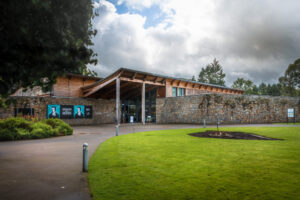Environmental sustainability: Robert Burns Birthplace Museum

The Project
Robert Burns Birthplace Museum is part of a larger experience and site in Alloway telling the story of Burns’ life inspiration, fame and identity. From the start of the redevelopment there was a strong sustainable agenda for the design of a ‘green’ building that would not only provide better conditions for the display and preservation of the collection, but would create a better experience for the visitor by allowing the story of Burns to be told in a much more innovative and engaging way.
The green building includes:
- Timber cladding from untreated Scottish Douglas-fir board (processed in Moray)
- A green roof, sown with a succulent called ‘sedum’, which cools the building during the summer and insulates it in the winter
- A Ground Source Heat Pump (GSHP), using underground pipes to extract the heat from the ground to heat the building as well as water supplies
- Earth-to-air heat exchanger providing space conditioning throughout the year
- Thermal mass wall – absorbing, storing and releasing heat through natural ventilation
- Solar panels attached to the glazing installed above the café, generating solar energy.
Ongoing green initiatives, which have also contributed to the museum being awarded a Green Tourism Gold Award, include: a green café – Healthy Living Award from NHS Scotland and using local suppliers; tours highlighting the green features of the building; information on walks and public transport; education centre, tying back to Burns’ native ‘Green story’; and, the recent restoration of Burns Monument and Burns Cottage ensuring both structures are more sound and sustainable, and will be around for generations to come.
Challenges and Successes
- With the collection positioned at the heart of the redevelopment, the building is now able to display most of its 5,000 artefacts to the public. Conditions are also better for its preservation, with dedicated storage rooms for manuscripts and heavier items.
- This project tapped into various sources of funding including capital funding. Subsequent funding has helped with ongoing maintenance of the collection and the museum, as well as continually improving the visitor experience.
- The green agenda for the building has become an integral part of the museum’s offering, providing an opportunity to educate visitors on its environmental impact.
The impact it has made
- The museum has been crucial to Alloway and Ayrshire, and has significantly increased tourism to the region. Each year the museum welcomes 300,000 visitors, including 4,000 school children as part of the Burns educational program.
- The Museum also employs around 50 full-time and part-time staff and has the support of over 50 NTS volunteers. The Museum works very closely with local suppliers for its shop and café produce and with local contractors for regular maintenance work and project work, including specialist works such thatching and stonemasonry.
- A wonderful space has been created for the local community – to play, learn, attend events and functions, and to be together.
- Creating a green museum has had an economic as well as environmental impact: no fuel deliveries; fuel bills are lower; free heating and hot water; and, the green roof will not only last longer than a conventional roof, it is more energy efficient (and has encouraged wildlife and biodiversity).
- There is now a state-of-the-art museum celebrating the life of Robert Burns, which will be here for the future generations, thanks also to the on-going maintenance plan that is now in place.
"This is a fantastic building to work in. I love how 21st century technology can work alongside historical artefacts to create a truly unique experience for the visitor and preserve Scotland's history for future generations."
Gavin Pettigrew, Facilities Manager, Robert Burns Birthplace Museum
Lessons Learned
- A maintenance plan was only brought on board later, following the redevelopment.
- Ensuring you have the means to ‘keep on going’, is key to the succession of any project.
Think of hidden costs, maintenance costs for sustainable energy equipment and the costs of ever-changing technology. - What was hi-tech 10 years ago, is not necessarily the case now. LED lighting had not been considered ten years ago and is now something the museum is starting to introduce.
Guidance
- You do not necessarily need access to capital funding to consider becoming a greener museum. There are many green options that can be explored from single solar panels, to greener alternatives in the café or gift shop.
- Have a realistic plan of any changes you can incorporate now, and in the future, and explore the funding options available, from MGS and other organisations.
- Once you have introduced greener measures, make sure you talk about it with your visitors, make it part of your story, and explain what it takes to maintain the building. Get them involved. Highlight the environmental impact of these changes.
If you would like more information about this project please contact
Gavin Pettigrew, Facilities Manager, Robert Burns Birthplace Museum, GPettigrew@nts.org.uk
Funding enquiries:
https://www.museumsgalleriesscotland.org.uk/funding/
Climate Heritage Network (be a part of tackling change):
http://climateheritage.org/join/